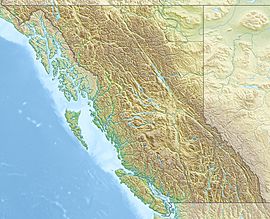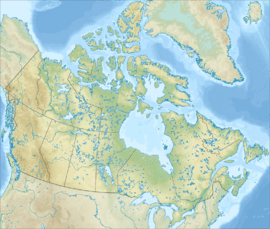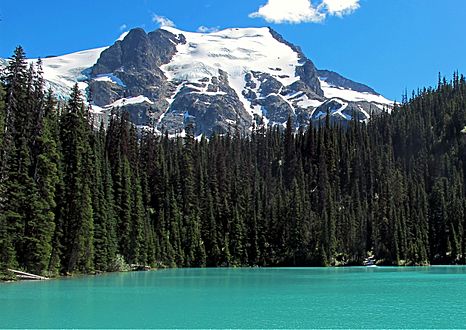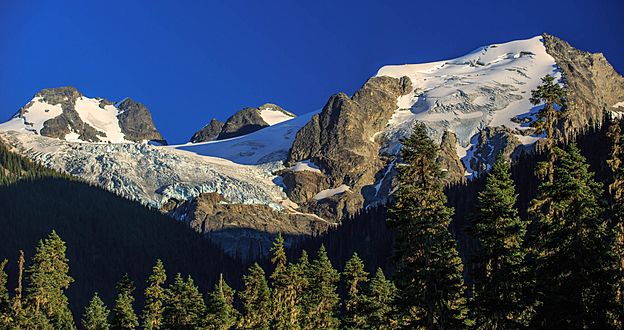Slalok Mountain facts for kids
Quick facts for kids Slalok Mountain |
|
|---|---|
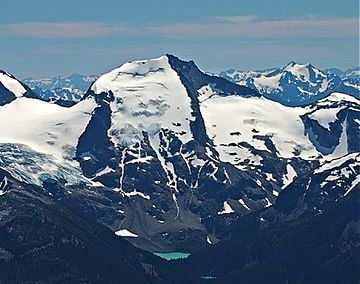
Slalok Mountain, north aspect, featuring left to right the Matier, Stonecrop, and Tszil Glaciers and Upper Joffre Lake below
|
|
| Highest point | |
| Elevation | 2,653 m (8,704 ft) |
| Prominence | 333 m (1,093 ft) |
| Parent peak | Mount Matier (2783 m) |
| Geography | |
| Location | Joffre Lakes Provincial Park British Columbia, Canada |
| Parent range | Joffre Group Lillooet Ranges Coast Ranges |
| Topo map | NTS 92J/8 |
| Climbing | |
| First ascent | 1963 C. Adam, T. Anderson, G. Richardson |
| Easiest route | Scrambling, glacier travel |
Slalok Mountain is a tall mountain peak in British Columbia, Canada. It stands at 2,653 meters (about 8,704 feet) high. This mountain is part of the Coast Mountains range. You can find it inside Joffre Lakes Provincial Park.
Slalok Mountain is the third-highest point in a group of mountains called the Joffre Group. This group is part of the larger Lillooet Ranges. The mountain is about 24 kilometers (15 miles) east of Pemberton. It's also 8 kilometers (5 miles) northeast of Lillooet Lake.
The closest higher mountain is Mount Matier, which is about 1.9 kilometers (1.2 miles) to the east. Water from Slalok Mountain flows into Joffre Creek and Twin One Creek. These creeks then join the Lillooet River.
The first time people successfully climbed to the top of Slalok Mountain was in 1963. The climbers were C. Adam, T. Anderson, and G. Richardson.
The mountain was first called Rex's Pillar. But its name was later changed to Slalok. This name comes from the traditional name for the nearby community of Mount Currie. The new name was officially accepted on June 11, 1979. This was done by the Geographical Names Board of Canada.
Slalok Mountain is home to three glaciers on its northern sides. These are the Matier Glacier, Stonecrop Glacier, and Tszil Glacier.
Mountain Weather and Climate
Slalok Mountain is in a cold climate zone called a subarctic climate. This type of climate is found in western North America.
Most of the weather systems that bring rain and snow start over the Pacific Ocean. They then move east towards the Coast Mountains. When these weather systems hit the mountains, they are forced to rise. This process is called Orographic lift. As the air rises, it cools down and drops its moisture. This means the Coast Mountains get a lot of rain or snow.
Winters on Slalok Mountain can be very cold. Temperatures can drop below -20 degrees Celsius (-4 degrees Fahrenheit). With the wind, it can feel even colder, sometimes below -30 degrees Celsius (-22 degrees Fahrenheit).
The best time to climb Slalok Mountain is usually from July through September. The weather during these months is more favorable for outdoor activities.
Climbing Adventures
There are several known ways to climb Slalok Mountain. These routes offer different challenges for climbers.
- Southwest Ridge - This route has a climbing difficulty rating.
- Matier Glacier - This route is often used for ski ascents.
- Northeast Ridge
- North Face (Stonecrop Glacier)
Images for kids
-
The Joffre Group: Joffre Peak (left), Mt. Matier (highest), Hartzell, Spetch, Slalok Mountain, Tszil, and Taylor (farthest right)


